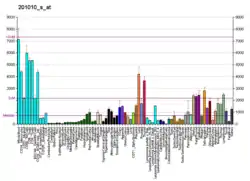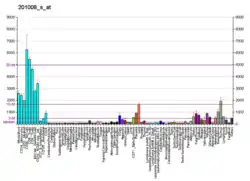TXNIP
Thioredoxin-interacting protein is a protein that in humans is encoded by the TXNIP gene.[5][6]
Interactions
TXNIP has been shown to interact with Thioredoxin[7] and ZBTB32.[8]
Related gene problems
References
- GRCh38: Ensembl release 89: ENSG00000265972 - Ensembl, May 2017
- GRCm38: Ensembl release 89: ENSMUSG00000038393 - Ensembl, May 2017
- "Human PubMed Reference:". National Center for Biotechnology Information, U.S. National Library of Medicine.
- "Mouse PubMed Reference:". National Center for Biotechnology Information, U.S. National Library of Medicine.
- Chen KS, DeLuca HF (Sep 1994). "Isolation and characterization of a novel cDNA from HL-60 cells treated with 1,25-dihydroxyvitamin D-3". Biochimica et Biophysica Acta (BBA) - Gene Structure and Expression. 1219 (1): 26–32. doi:10.1016/0167-4781(94)90242-9. PMID 8086474.
- "Entrez Gene: TXNIP thioredoxin interacting protein".
- Nishiyama A, Matsui M, Iwata S, Hirota K, Masutani H, Nakamura H, Takagi Y, Sono H, Gon Y, Yodoi J (Jul 1999). "Identification of thioredoxin-binding protein-2/vitamin D(3) up-regulated protein 1 as a negative regulator of thioredoxin function and expression". The Journal of Biological Chemistry. 274 (31): 21645–50. doi:10.1074/jbc.274.31.21645. PMID 10419473.
- Han SH, Jeon JH, Ju HR, Jung U, Kim KY, Yoo HS, Lee YH, Song KS, Hwang HM, Na YS, Yang Y, Lee KN, Choi I (Jun 2003). "VDUP1 upregulated by TGF-beta1 and 1,25-dihydorxyvitamin D3 inhibits tumor cell growth by blocking cell-cycle progression". Oncogene. 22 (26): 4035–46. doi:10.1038/sj.onc.1206610. PMID 12821938.
Further reading
- Nishiyama A, Matsui M, Iwata S, Hirota K, Masutani H, Nakamura H, Takagi Y, Sono H, Gon Y, Yodoi J (Jul 1999). "Identification of thioredoxin-binding protein-2/vitamin D(3) up-regulated protein 1 as a negative regulator of thioredoxin function and expression". The Journal of Biological Chemistry. 274 (31): 21645–50. doi:10.1074/jbc.274.31.21645. PMID 10419473.
- Ludwig DL, Kotanides H, Le T, Chavkin D, Bohlen P, Witte L (May 2001). "Cloning, genetic characterization, and chromosomal mapping of the mouse VDUP1 gene". Gene. 269 (1–2): 103–12. doi:10.1016/S0378-1119(01)00455-3. PMID 11376942.
- Bodnar JS, Chatterjee A, Castellani LW, Ross DA, Ohmen J, Cavalcoli J, Wu C, Dains KM, Catanese J, Chu M, Sheth SS, Charugundla K, Demant P, West DB, de Jong P, Lusis AJ (Jan 2002). "Positional cloning of the combined hyperlipidemia gene Hyplip1". Nature Genetics. 30 (1): 110–6. doi:10.1038/ng811. PMC 2846781. PMID 11753387.
- Joguchi A, Otsuka I, Minagawa S, Suzuki T, Fujii M, Ayusawa D (Apr 2002). "Overexpression of VDUP1 mRNA sensitizes HeLa cells to paraquat". Biochemical and Biophysical Research Communications. 293 (1): 293–7. doi:10.1016/S0006-291X(02)00208-5. PMID 12054598.
- Butler LM, Zhou X, Xu WS, Scher HI, Rifkind RA, Marks PA, Richon VM (Sep 2002). "The histone deacetylase inhibitor SAHA arrests cancer cell growth, up-regulates thioredoxin-binding protein-2, and down-regulates thioredoxin". Proceedings of the National Academy of Sciences of the United States of America. 99 (18): 11700–5. Bibcode:2002PNAS...9911700B. doi:10.1073/pnas.182372299. PMC 129332. PMID 12189205.
- Schulze PC, De Keulenaer GW, Yoshioka J, Kassik KA, Lee RT (Oct 2002). "Vitamin D3-upregulated protein-1 (VDUP-1) regulates redox-dependent vascular smooth muscle cell proliferation through interaction with thioredoxin". Circulation Research. 91 (8): 689–95. doi:10.1161/01.RES.0000037982.55074.F6. PMID 12386145.
- Han SH, Jeon JH, Ju HR, Jung U, Kim KY, Yoo HS, Lee YH, Song KS, Hwang HM, Na YS, Yang Y, Lee KN, Choi I (Jun 2003). "VDUP1 upregulated by TGF-beta1 and 1,25-dihydorxyvitamin D3 inhibits tumor cell growth by blocking cell-cycle progression". Oncogene. 22 (26): 4035–46. doi:10.1038/sj.onc.1206610. PMID 12821938.
- Champliaud MF, Viel A, Baden HP (Oct 2003). "The expression of vitamin D-upregulated protein 1 in skin and its interaction with sciellin in cultured keratinocytes". The Journal of Investigative Dermatology. 121 (4): 781–5. doi:10.1046/j.1523-1747.2003.12539.x. PMID 14632196.
- Kim KY, Shin SM, Kim JK, Paik SG, Yang Y, Choi I (Mar 2004). "Heat shock factor regulates VDUP1 gene expression". Biochemical and Biophysical Research Communications. 315 (2): 369–75. doi:10.1016/j.bbrc.2004.01.047. PMID 14766217.
- Schulze PC, Yoshioka J, Takahashi T, He Z, King GL, Lee RT (Jul 2004). "Hyperglycemia promotes oxidative stress through inhibition of thioredoxin function by thioredoxin-interacting protein". The Journal of Biological Chemistry. 279 (29): 30369–74. doi:10.1074/jbc.M400549200. PMID 15128745.
- Coon H, Singh N, Dunn D, Eckfeldt JH, Province MA, Hopkins PN, Weiss R, Hunt SC, Leppert MF (Jun 2004). "TXNIP gene not associated with familial combined hyperlipidemia in the NHLBI Family Heart Study". Atherosclerosis. 174 (2): 357–62. doi:10.1016/j.atherosclerosis.2004.02.004. PMID 15136067.
- Nishinaka Y, Masutani H, Oka S, Matsuo Y, Yamaguchi Y, Nishio K, Ishii Y, Yodoi J (Sep 2004). "Importin alpha1 (Rch1) mediates nuclear translocation of thioredoxin-binding protein-2/vitamin D(3)-up-regulated protein 1". The Journal of Biological Chemistry. 279 (36): 37559–65. doi:10.1074/jbc.M405473200. PMID 15234975.
- Aitken CJ, Hodge JM, Nishinaka Y, Vaughan T, Yodoi J, Day CJ, Morrison NA, Nicholson GC (Dec 2004). "Regulation of human osteoclast differentiation by thioredoxin binding protein-2 and redox-sensitive signaling". Journal of Bone and Mineral Research. 19 (12): 2057–64. doi:10.1359/JBMR.040913. PMID 15537450. S2CID 26600161.
- Yamawaki H, Pan S, Lee RT, Berk BC (Mar 2005). "Fluid shear stress inhibits vascular inflammation by decreasing thioredoxin-interacting protein in endothelial cells". The Journal of Clinical Investigation. 115 (3): 733–8. doi:10.1172/JCI23001. PMC 546457. PMID 15696199.
- Minn AH, Hafele C, Shalev A (May 2005). "Thioredoxin-interacting protein is stimulated by glucose through a carbohydrate response element and induces beta-cell apoptosis". Endocrinology. 146 (5): 2397–405. doi:10.1210/en.2004-1378. PMID 15705778.
This article is issued from Wikipedia. The text is licensed under Creative Commons - Attribution - Sharealike. Additional terms may apply for the media files.






